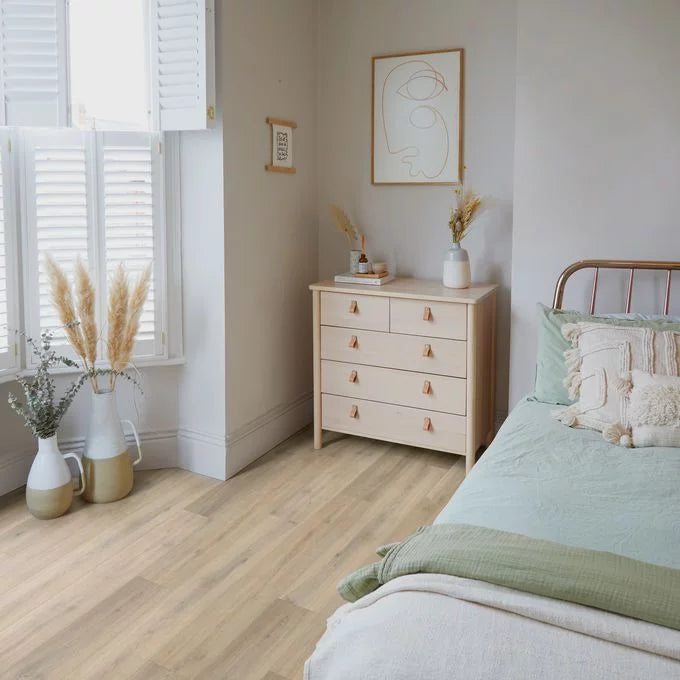
Why Is Wood-Effect Vinyl Flooring So Popular In Kitchens?
Share
Natural-looking flooring is ironically particularly popular in the types of rooms and settings where it is perhaps least suited from a practical standpoint.
A lot of popular types of stone used for tabletops and flooring are permeable and thus surprisingly vulnerable to scratches, stains and efflorescence despite often having polished, smooth finishes.
Rather less surprisingly, wood tends to be particularly vulnerable to the types of humid, wet conditions that are typically found in a commonly used kitchen.
This has made wood-look vinyl a particularly popular alternative, but what particular advantages does it have over its natural namesake?
Water And Humidity Resistance
Most homes and many commercial settings can neatly divide and categorise the many different types of rooms available into wet and dry rooms.
Dry rooms are the vast majority of the rooms in the house where there are no sinks, taps, basins or other pieces of furniture or equipment which dispense running water. Typically, the only water in these rooms flows through radiators or underfloor pipework.
By contrast, wet rooms such as bathrooms, kitchens, laundry rooms and wet rooms themselves have varying levels of not only running, spilling and splashing water, but also humidity, the concentration of water vapour in the air.
Wood is particularly affected by moisture content, expanding and contracting based on the relative humidity; this is a major reason why wooden doors will sometimes get stuck during rainstorms and other conditions with high humidity.
Too much water can cause damage to wooden flooring and even potentially lead to significant swelling, warping, and even rotting without regular sealing, cleaning and maintenance.
By contrast, vinyl tiles are engineered to be particularly water resistant, meaning that they are far better suited to be used in kitchens where there will inevitably be spills and splashes.
They also tend to have multiple engineered layers, making them much less susceptible to changes in moisture levels.
Less Prone To Wear And Tear
Wooden flooring is susceptible to scuffs, scratches and dents, and whilst this can be an issue in any room, kitchens tend to be particularly high traffic areas and places where people are most likely to wear hard shoes or boots.
This increases the risk of damage that is difficult to fix, which makes frequent preventative maintenance and clearing dirt and debris quickly far more critical than it otherwise would be.
This is particularly true if the kitchen is one of the entry points to the house or building, which, whilst not universal, is a remarkably common floorplan for detached and semi-detached houses.
Whilst it is possible to get around this by being strict about shoes and regimented in cleaning and maintaining the floor, an easier solution is to use vinyl tiles instead.
They have a strong, thick layer of protection over the detailed photographic layer with the wood-effect texture, which requires little maintenance to protect and can withstand intense foot traffic for years, depending on the type of luxury vinyl tiles used.
More Affordable
Natural wooden flooring is expensive, especially as many previously ideal hardwood species become endangered or harder to source.
Even alternatives such as reclaimed or engineered wood can be somewhat costly depending on the finish and quality you are looking for, and whilst sourcing particularly rustic and characterful pieces can sometimes be part of the charm of natural wood, it can be difficult to find the right pieces.
The same effect can be found using wood-effect LVTs at a fraction of the cost.
This is not only true of the cost per square metre, but also the cost of installation. LVT is particularly easy to install, with some products simply requiring planks or tiles to be snapped together.
By contrast, natural wood flooring typically needs to be professionally installed for the best results, particularly in kitchens and bathrooms where the potential for expansion due to humidity is almost guaranteed.
Easier To Replace
Replacing worn-out parts of a wooden floor is not as difficult as, for example, marble or granite, but it is a significant endeavour that requires not only time to lever out the particular planks that require removal but also to source suitable replacements that appropriately cohere with the existing shape and grain.
Whilst wooden planks do not need to be an identical colour to each other, using significantly different pieces of wood from each other can stand out in a less than positive way.
By contrast, replacing an LVT plank or panel is a simple process that many people can do themselves, further saving time and money.
